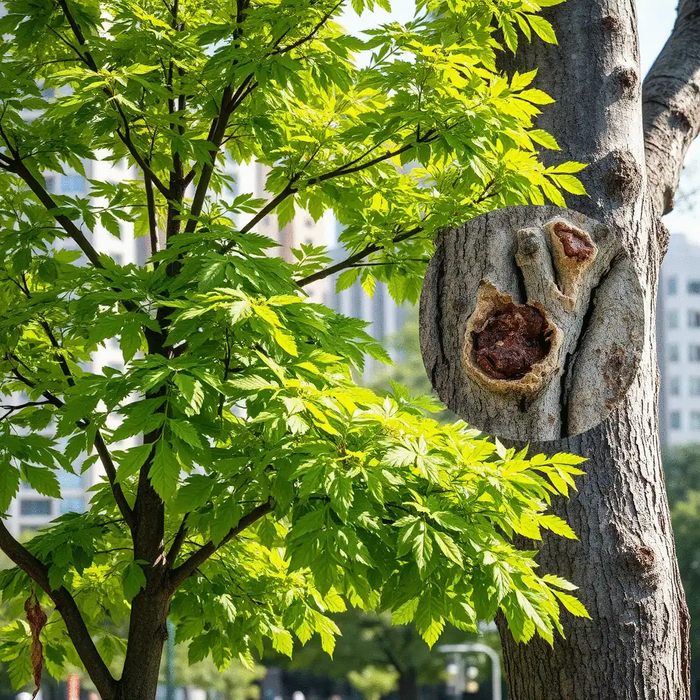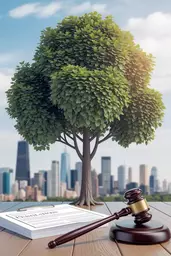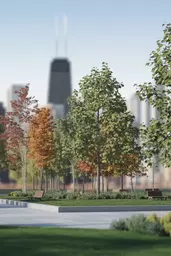Urban Tree Disease Treatment Guide

Posted on: 2025-06-13
By: Keira Vallejo
Urban trees are essential to our cities, yet they face numerous threats that can compromise their health. Understanding these challenges is the first step towards ensuring vibrant urban ecosystems. Join us as we delve into the importance of maintaining urban tree health and how you can contribute.
What You Will Learn
- The vital role of urban trees in improving air quality, reducing noise, and enhancing property values.
- Common tree diseases like anthracnose, oak wilt, and bacterial leaf scorch and their symptoms.
- The significance of urban forestry in managing tree health and fostering community involvement.
- The necessity of regular tree inspections and proactive measures to address symptoms early.
- The impact of climate change on urban tree health, including new pests and increased stress factors.
- Ways to engage with your community to promote tree care and advocate for urban tree health initiatives.
Key Benefits of Urban Trees
Urban trees provide essential environmental benefits, helping to create healthier urban spaces.
Improved Air Quality
Trees filter pollutants and release oxygen.
+30%
Air quality improvement
Noise Reduction
Trees absorb sound, creating quieter spaces.
-50%
Noise level decrease
Increased Property Values
Well-maintained trees can boost neighborhood appeal.
+15%
Property value increase
Climate Regulation
Trees help moderate temperatures in urban areas.
-2°C
Temperature reduction
Understanding Common Tree Diseases in Urban Environments
Urban trees play a vital role in our cities, offering a multitude of benefits. They improve air quality by absorbing pollutants, provide shade that reduces urban heat, and enhance the overall aesthetics of our neighborhoods. These leafy giants are not just pretty to look at; they contribute to our physical and mental well-being, making our urban spaces feel more inviting and serene.
However, maintaining the health of these trees is crucial for maximizing their benefits. As trees face various stresses in urban settings, such as pollution, limited space, and climate variations, they become more susceptible to diseases. This is why understanding tree health is a priority for anyone who loves their city and wants to enjoy the shade of a healthy tree!
The Importance of Urban Tree Health
Healthy trees are the backbone of vibrant urban ecosystems. They provide habitat for wildlife, reduce heat in the summer, and even improve our mental health by offering green spaces where we can connect with nature. In cities where concrete dominates, trees act as vital lungs, purifying the air we breathe.
Moreover, the aesthetic aspect of trees cannot be understated. They create beautiful landscapes that make our neighborhoods more attractive and enjoyable. By nurturing urban tree health, we’re not only enhancing our environment but also enriching our community’s quality of life. Understanding the connection between trees and property value can further emphasize their importance.
- Improved air quality: Trees filter pollutants and release oxygen.
- Noise reduction: Trees absorb sound, creating quieter spaces.
- Increased property values: Well-maintained trees can boost neighborhood appeal.
- Climate regulation: Trees help moderate temperatures in urban areas.
Recognizing Common Tree Diseases in Cities
Urban trees face unique challenges that can lead to a variety of diseases. Some common diseases include anthracnose, oak wilt, and bacterial leaf scorch. Each of these can severely affect not just the health of the tree but also the beauty of our urban landscapes.
Understanding these diseases and their symptoms is essential for effective management. For instance, a tree suffering from oak wilt can spread the disease to other nearby oaks, leading to a rapid decline in tree health. That’s why early detection is crucial!
- Anthracnose: Leads to leaf spots and can distort growth.
- Oak Wilt: Causes leaf discoloration and wilting.
- Bacterial Leaf Scorch: Results in leaf browning and premature drop.
Urban Forestry and Its Role in Tree Health
Urban forestry is the practice of managing and caring for trees in urban settings. It plays a vital role in maintaining tree health and supporting biodiversity. Through careful planning and management, urban foresters can help ensure that trees thrive in their challenging environments.
One of the key aspects of urban forestry is community involvement. By engaging with residents, urban foresters can educate them about tree care and disease prevention, fostering a culture of stewardship within the community. When we all take part in caring for our trees, we create a stronger, healthier urban landscape!
- Tree planting initiatives: Encouraging community members to plant native species.
- Regular inspections: Monitoring tree health to catch issues early.
- Education programs: Providing workshops on tree care and disease management.
Pro Tip
Did you know? Regularly monitoring soil health can significantly enhance your trees' resilience against diseases. Soil health influences tree growth, nutrient uptake, and overall vitality. Consider conducting soil tests to check pH levels and nutrient content, and amend your soil accordingly. Healthy soil fosters robust trees that can better withstand urban challenges!
Summarizing Key Takeaways on Tree Disease Management
As we wrap up our discussion on tree diseases, it's important to reflect on the essential points we've covered. Urban trees are invaluable, contributing to our city's air quality, aesthetics, and overall well-being. Understanding common tree diseases and their symptoms is the first step toward effective management. Remember, timely action can make a significant difference in maintaining tree health and ensuring that our urban landscapes thrive.
From recognizing symptoms like anthracnose and oak wilt to exploring prevention strategies through proper pruning and soil care, we’ve highlighted various approaches to keep our trees healthy. Urban Canopy Blog believes that informed communities can create a greener, healthier environment and help our trees flourish despite the challenges they face.
Frequently Asked Questions (FAQs)
- Why are urban trees important?
- Urban trees improve air quality, reduce noise pollution, increase property values, and help regulate climate.
- What are some common tree diseases in urban environments?
- Common diseases include anthracnose, oak wilt, and bacterial leaf scorch.
- How can urban forestry help maintain tree health?
- Urban forestry involves managing and caring for trees through planting initiatives, regular inspections, and education programs.
- What are the impacts of climate change on urban tree health?
- Climate change can lead to increased stress, new pests and diseases, and altered precipitation patterns, affecting tree health.
- How can communities get involved in urban tree care?
- Communities can participate in tree planting initiatives, volunteer days, and educational workshops to promote tree health and maintenance.
The Importance of Timely Action in Urban Tree Care
Taking quick action when you notice symptoms is crucial for the health of urban trees. Symptoms, if left untreated, can escalate quickly, leading to severe damage or even tree loss. To help you stay proactive, here's a quick checklist of actions to take:
- Regularly inspect trees for signs of distress, such as wilting leaves or unusual spots.
- If you notice symptoms, research the issue or consult local resources, like Urban Canopy Blog, for guidance.
- Consider implementing treatment strategies or contacting a professional if symptoms worsen.
- Engage your community in tree care efforts to spread awareness and knowledge!
By being alert and responsive, you can greatly enhance the resilience of urban trees and help them combat potential threats. This proactive approach not only supports individual trees but also contributes to the overall health of our urban forests.
Climate Change Impact on Urban Tree Health
Climate change poses new challenges for our urban trees, making it vital to understand its impact on tree health. Fluctuating temperatures, altered precipitation patterns, and increased pest activity can exacerbate tree diseases. Here are some key aspects to consider:
- Increased Stress: Urban trees are already facing stress from pollution and limited space. Climate change adds another layer.
- New Pests and Diseases: Warmer climates can lead to the emergence of new pests and diseases that threaten tree health.
- Resilience Strategies: Implementing sustainable practices, such as selecting disease-resistant species, can enhance urban forests' resilience. It's especially important to focus on choosing the right trees for your specific climate.
By understanding these impacts, we can better prepare our urban landscapes for future challenges. At Urban Canopy Blog, we strive to educate and empower communities to take action against these pressing issues. Together, we can foster urban ecosystems that thrive even in changing climates!
Call to Action for Urban Tree Health Advocacy
Encouraging Community Action and Awareness
Now that we have a better grasp of tree diseases and their management, it’s time to take action! Engage with your community to promote tree health and maintenance. Here are some ways you can contribute:
- Join local tree care workshops or volunteer days organized by urban forestry groups.
- Share your tree care experiences on social media to inspire others!
- Start conversations about the importance of trees in your neighborhood.
- Participate in or create community initiatives aimed at enhancing green spaces.
Advocating for urban tree health not only supports our environment but also strengthens community ties. Every small action counts and contributes to a larger movement towards healthier urban ecosystems.
Resources for Further Learning on Tree Diseases
For those eager to dive deeper into the world of tree diseases and urban forestry, there are plenty of resources available. Here are some valuable links to get you started:
- Urban Canopy Blog Guides - Comprehensive articles on tree care, maintenance, and disease management.
- International Society of Arboriculture - Tips and resources from tree care professionals.
- Arbor Day Foundation - Educational materials and tree planting initiatives.
By utilizing these resources, you'll be well-equipped to tackle tree care challenges and contribute to a greener urban landscape. Remember, at Urban Canopy Blog, we're here to support you on this journey! For further assistance, consider exploring the benefits of professional tree care to ensure your urban trees thrive.
Recap of Key Points
Here is a quick recap of the important points discussed in the article:
- Urban Trees are Essential: They improve air quality, provide shade, and enhance neighborhood aesthetics.
- Common Tree Diseases: Awareness of diseases like anthracnose and oak wilt is crucial for early detection and management.
- Importance of Urban Forestry: Community involvement and education are key to maintaining tree health and biodiversity.
- Timely Action Matters: Regular inspections and quick responses to symptoms can prevent severe damage to trees.
- Climate Change Impacts: Urban trees face increased stress and new pests due to climate change, highlighting the need for resilient practices.
- Community Engagement: Participating in local tree care initiatives fosters awareness and strengthens community ties.
 In urban environments, trees are often the unsung heroes contributing to our well-being and the over
In urban environments, trees are often the unsung heroes contributing to our well-being and the over
 Urban trees are essential to our cities, yet they face numerous threats from pests and diseases. Did
Urban trees are essential to our cities, yet they face numerous threats from pests and diseases. Did
 Did you know that urban tree diversity is crucial not just for aesthetics, but for the health of ent
Did you know that urban tree diversity is crucial not just for aesthetics, but for the health of ent